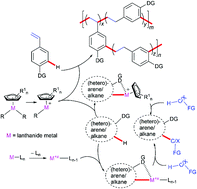Recent progress in rare-earth metal-catalyzed sp2 and sp3 C–H functionalization to construct C–C and C–heteroelement bonds†
Abstract
C–H functionalization is a fundamentally important organic transformation to access C–C and C–heteroatom bonds in a common and/or complex molecular set-up during the preparation of small molecule bio-active scaffolds and conglomerate molecular architectures, generating valuable structural diversity. C–H activation/functionalization has become routine in the toolbox of synthetic organic, medicinal and materials chemists. In the last few years, half-sandwich rare-earth metal-catalyzed C–C and C–heteroatom bond formation has gained significant momentum, which is enabled by C–H activation/functionalization in a highly site-/regio-, and enantio-/diastereo-selective manner. This account is focused on presenting an overview of the recent studies on different types of rare-earth metal-catalyzed organic transformations, such as C–C/C–heteroatom bond formation and olefin (co)-polymerization. Also, we discuss sp2 and sp3 C–H functionalization under the catalytic influence of rare-earth metal-elements, covering reports from 2010 to March 2021. Mechanistic considerations are covered briefly, wherein significant understanding was realized by both experimental studies and density functional theory calculations.

- This article is part of the themed collection: 2022 Organic Chemistry Frontiers Review-type Articles


 Please wait while we load your content...
Please wait while we load your content...